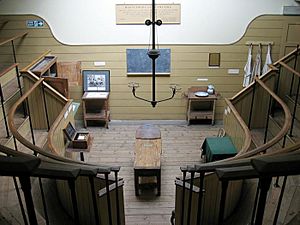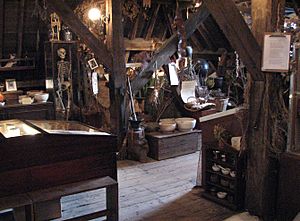Old Operating Theatre Museum and Herb Garret facts for kids

A look inside the old operating theatre.
|
|
| Established | 27 October 1962 |
|---|---|
| Location | 9a St Thomas Street London, SE1 United Kingdom |
| Type | Medical museum |
| Public transit access | |
The Old Operating Theatre Museum and Herb Garret is a museum in London that shows what surgery was like in the past. It has one of the oldest surviving operating theatres in Europe. The museum is hidden in the attic, or garret, of the old St Thomas's Church, which was once part of St Thomas' Hospital.
Contents
History of the Theatre
The Herb Garret
The church containing the museum was built around the end of the 17th century. Its attic was a large, open space. For a long time, people weren't sure what it was used for. In 1821, it was called "the herb garret." A garret is another word for an attic.
It was likely used by the hospital's apothecary (an early type of pharmacist) to store and dry herbs for making medicines. In fact, dried poppy heads, which were used in medicine, were found in the rafters.
Building an Operating Theatre
In 1822, a part of the herb garret was turned into an operating theatre. Before this, surgeries were done on the open hospital wards, which was not ideal. The new theatre was built in the attic because it was right next to the women's surgical ward. This made it easy to move patients to and from their beds.
Closing and Rediscovery
In 1859, the famous nurse Florence Nightingale began working with St Thomas's Hospital. She helped improve nursing care and advised the hospital to move to a new, better location.
In 1862, the hospital moved, and the old operating theatre was closed down. It was boarded up and forgotten for nearly 100 years. It was finally rediscovered in 1957, leading to the creation of the museum.
Surgery in the 1800s
A Time Before Modern Medicine
The patients who used this operating theatre were all women, and most were poor. Wealthy people usually had doctors visit and operate on them in their own homes.
Surgery was very different back then. Until 1847, there were no anaesthetics to put patients to sleep. This meant patients were awake during operations. Surgeons had to be incredibly fast. A skilled surgeon could perform an amputation in about a minute.
The theatre was also built before doctors understood the importance of keeping everything sterile. This meant that internal surgery was extremely dangerous, so most operations were for things on the outside of the body.
A Crowded Room
The operating theatre was also a classroom. Medical students would crowd into the room to watch the surgeons work and learn from them. A surgeon named John Flint South described the scene:
The first two rows ... were occupied by the other dressers, and behind a second partition stood the pupils, packed like herrings in a barrel... There was also a continual calling out of "Heads, Heads" to those about the table whose heads interfered with the sightseers.
Patients agreed to have an audience because it meant they could be treated by some of the best surgeons for free, which they could not otherwise afford.
Dangers of Infection
One of the biggest dangers was infection. Doctors did not yet know that germs caused disease. Surgeons often wore the same coats for many operations, which became dirty and were not washed between patients. Below the operating table, there was a wooden box filled with sawdust to catch blood. Because of these unhygienic conditions and the shock of the surgery, many patients did not survive.
The Museum Today
The garret and operating theatre were opened to the public as a museum in 1962. Today, you can visit and see:
- The oldest surviving operating theatre in the UK, set up as it was in 1822.
- The herb garret, where the apothecary prepared plant-based medicines.
- A collection of old medical tools used for procedures like bleeding and trepanning (drilling a hole in the skull).
- Exhibits about the history of St Thomas's and Guy's hospitals, Florence Nightingale, and herbal medicine.
The museum building is considered very important and is a Grade II* listed building. The nearest train and underground station is London Bridge.


